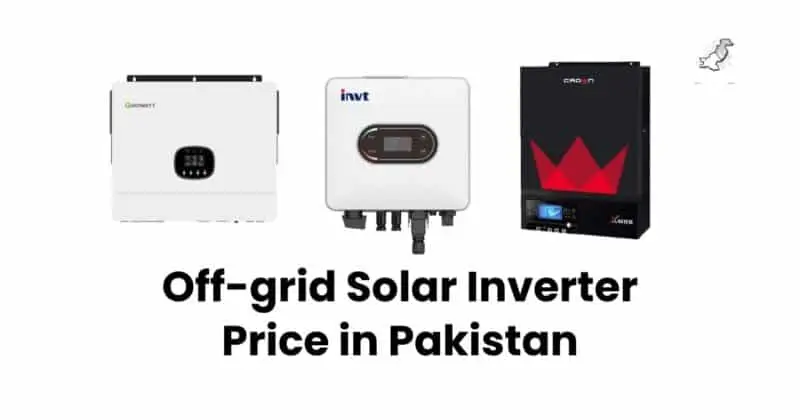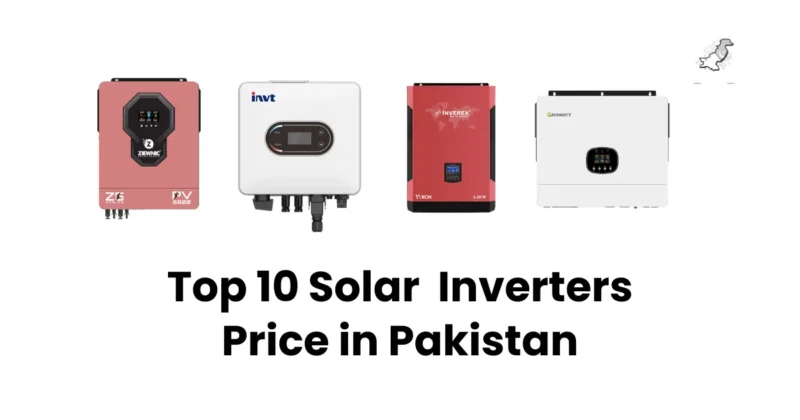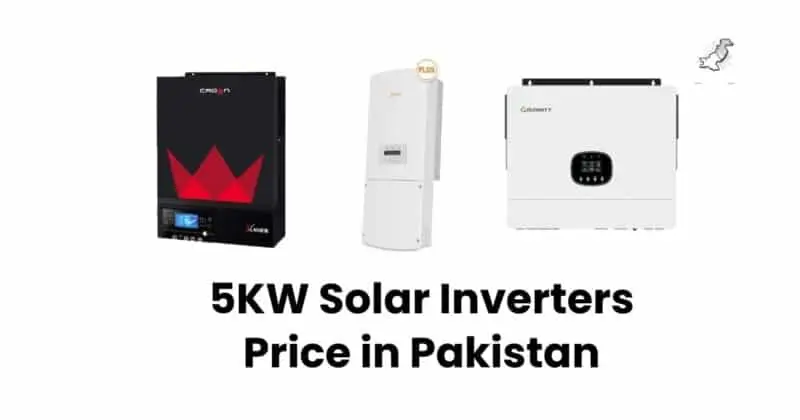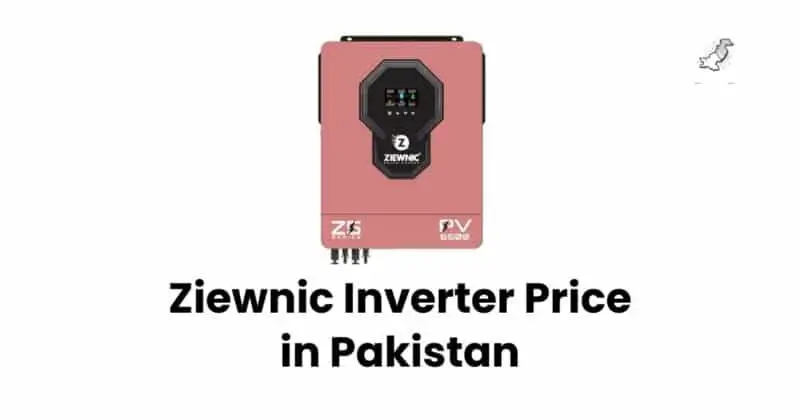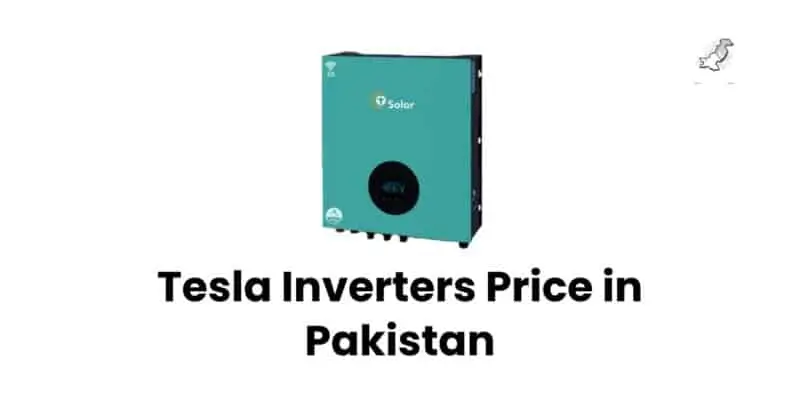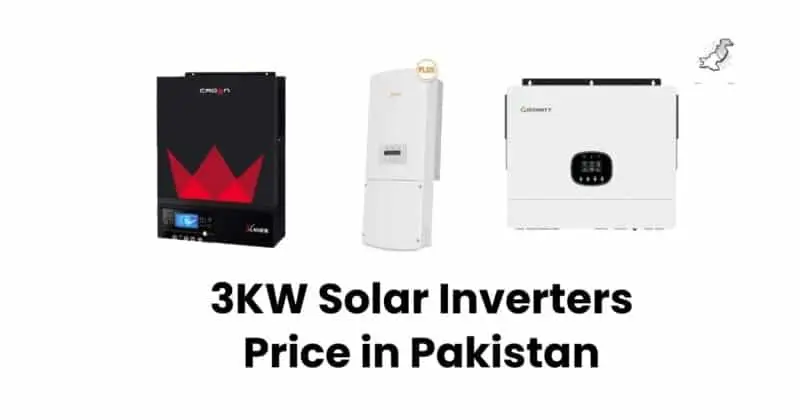On-Grid Solar Inverter Price in Pakistan – Complete Guide 2025

On-grid solar inverter prices in Pakistan range from Rs. 165,000 to Rs. 660,000 depending on capacity and brand. Popular brands like Solis start at Rs. 165,000 for 3kW systems, while premium options like Growatt can cost up to Rs. 660,000 for 25kW+ commercial installations.
Introduction to On-Grid Solar Inverters
Your electricity bill keeps climbing higher each month. Power outages disrupt your daily routine when you least expect it. You’re tired of watching your hard-earned money disappear into utility bills that seem to grow larger every quarter.
What if you could slash those bills by 70-80% while gaining energy independence? That’s exactly what on-grid solar inverters make possible in Pakistan. These smart devices convert your solar panels’ DC power into AC electricity that feeds directly into your home and the national grid.
The best part? You get paid for excess electricity through net metering. Think of it like having your own mini power plant that actually puts money back in your pocket. No more worrying about surprise bills or planning your day around load shedding schedules.
What is an On-Grid Solar Inverter?
An on-grid solar inverter converts DC electricity from solar panels into AC power that synchronizes with Pakistan’s national electricity grid. It automatically feeds excess power back to WAPDA, earning you credits on your electricity bill through net metering.
Picture your solar inverter as a smart translator. Solar panels speak “DC language” but your home appliances only understand “AC language.” The inverter translates between them seamlessly. When your panels produce more power than you’re using, it sends that extra juice back to the grid.
This isn’t just theory – it’s happening in thousands of Pakistani homes right now. Families in Lahore report cutting their monthly bills from Rs. 25,000 to just Rs. 3,000. That’s real money staying in their pockets instead of going to the utility company.
How On-Grid Inverters Work
On-grid inverters monitor grid frequency and voltage continuously, converting solar DC power to matching AC power. They automatically shut down during grid outages for safety and restart when power returns, ensuring seamless integration with WAPDA’s electrical network.
The process works like a perfectly choreographed dance. Your inverter constantly checks the grid’s “heartbeat” – its frequency and voltage. When everything matches perfectly, it feeds your solar power into the system. If the grid goes down, your inverter immediately stops sending power to protect line workers.
This smart safety feature means you won’t have backup power during outages. But here’s the trade-off that makes sense for most Pakistani families: you get the cheapest solar solution with the fastest payback period.
Benefits of On-Grid Solar Systems
On-grid systems offer the lowest upfront costs, fastest ROI (2-3 years), and highest long-term savings through net metering. They require minimal maintenance, have longest inverter lifespans, and provide maximum electricity bill reduction without battery replacement costs.
Let me paint you a picture of what this means for your wallet. A typical 5kW on-grid system costs around Rs. 600,000. Compare that to a hybrid system at Rs. 1,200,000. You save Rs. 600,000 upfront and start earning back your investment immediately.
The numbers get even better with time. Net metering means WAPDA essentially becomes your free battery. Generate excess power during sunny days? They store it as credits. Use more power at night? You draw from those credits first.
No battery maintenance headaches. No replacement costs every 5-7 years. Just clean, simple solar power that keeps working for 25+ years. That’s the beauty of keeping things simple.
On-Grid Solar Inverter Price Analysis Pakistan
Current Market Prices (2025)
On-grid solar inverter prices in Pakistan currently range from Rs. 165,000 for basic 3kW units to Rs. 660,000 for high-capacity 25kW commercial systems. Average residential 5kW systems cost between Rs. 220,000-280,000 depending on brand and features.
The Pakistani solar market has matured significantly. Gone are the days of wild price swings and unreliable products. Today’s pricing reflects real competition between established brands fighting for your business.
Here’s what drives these price ranges: entry-level Chinese brands compete aggressively on cost, while premium European and Japanese brands command higher prices for advanced features. Pakistani-assembled units from companies like Inverex offer middle-ground pricing with local support.
Price Comparison by Capacity (3kW to 25kW)
| Capacity | Budget Range | Mid-Range | Premium | Best Value |
| 3kW | Rs. 165,000 – 180,000 | Rs. 200,000 – 230,000 | Rs. 250,000 – 300,000 | Solis 3kW |
| 5kW | Rs. 220,000 – 245,000 | Rs. 260,000 – 295,000 | Rs. 320,000 – 380,000 | Inverex 5kW |
| 8kW | Rs. 310,000 – 350,000 | Rs. 380,000 – 430,000 | Rs. 450,000 – 520,000 | Growatt 8kW |
| 10kW | Rs. 380,000 – 420,000 | Rs. 450,000 – 510,000 | Rs. 550,000 – 650,000 | GoodWe 10kW |
| 15kW | Rs. 520,000 – 580,000 | Rs. 620,000 – 720,000 | Rs. 780,000 – 900,000 | Huawei 15kW |
| 25kW | Rs. 780,000 – 850,000 | Rs. 920,000 – 1,100,000 | Rs. 1,200,000+ | Solis 25kW |
The sweet spot for most Pakistani homes? 5kW to 8kW systems. They balance upfront costs with meaningful bill reduction. A 5kW system typically covers 60-80% of average household consumption.
Bigger isn’t always better. Calculate your actual usage first. Installing a 10kW system when you only need 5kW wastes money upfront and reduces your net metering benefits.
Regional Price Variations (Karachi, Lahore, Islamabad)
| City | Price Premium | Delivery Cost | Installation | Total Impact |
| Karachi | Base Price | Free | Rs. 15,000-25,000 | Lowest Overall |
| Lahore | +2-5% | Rs. 5,000-8,000 | Rs. 18,000-30,000 | Moderate |
| Islamabad | +3-7% | Rs. 8,000-12,000 | Rs. 20,000-35,000 | Higher |
| Peshawar | +5-10% | Rs. 12,000-18,000 | Rs. 25,000-40,000 | Highest |
| Multan | +3-6% | Rs. 6,000-10,000 | Rs. 18,000-28,000 | Moderate-High |
Karachi leads with lowest prices due to port proximity and higher competition. Most importers base operations here, cutting logistics costs. Lahore follows closely with competitive dealer networks.
Smaller cities pay more but gain better personal service. Dealers in Multan or Peshawar often provide more hands-on support than busy Karachi operations. Factor this into your decision.
Factors Affecting Inverter Prices
Five main factors drive on-grid inverter pricing: brand reputation (20-30% price difference), efficiency ratings (higher efficiency costs 15-25% more), warranty periods (extended warranties add 10-15%), power capacity (linear scaling), and import duties (adding 25-35% to base costs).
Brand reputation carries real weight here. European brands like Fronius cost more but offer rock-solid reliability. Chinese brands offer aggressive pricing but varying quality levels. Pakistani-assembled options provide local support advantages.
Efficiency matters more than you think. A 96% efficient inverter wastes 4% of your solar power as heat. A 98.5% efficient unit only wastes 1.5%. Over 25 years, that difference pays for the higher upfront cost.Currency fluctuations hit hard too. PKR weakness against USD or EUR directly increases prices. Smart buyers watch exchange rates and time purchases during PKR strength periods.
Top On-Grid Solar Inverter Brands in Pakistan
Inverex On-Grid Inverters (Price Range: Rs. 180,000 – Rs. 520,000)
Inverex dominates Pakistan’s solar market with 35% market share, offering locally-assembled inverters from Rs. 180,000 for 3kW units to Rs. 520,000 for 20kW systems. Their Nitrox series provides excellent value with 5-year warranties and nationwide service support.
Here’s why Inverex leads the pack: they understand Pakistani conditions. Dust, heat, humidity, voltage fluctuations – their engineers design for our reality, not European labs. That’s why you see Inverex systems running smoothly after 8+ years while some imported brands struggle.
Their service network spans every major city. Need support in Sialkot or Sukkur? Inverex has you covered. Try getting that level of service from a purely imported brand.
Popular Models:
- Nitrox 5kW: Rs. 225,000 (Best seller for residential)
- Nitrox 10kW: Rs. 355,000 (Popular for large homes)
- Nitrox 15kW: Rs. 485,000 (Small commercial favorite)
Solis On-Grid Inverters (Price Range: Rs. 165,000 – Rs. 405,000)
Solis offers Pakistan’s most affordable on-grid inverters without compromising quality, starting at Rs. 165,000 for 3kW units. Their 4G series achieves 98.1% efficiency with ultra-low startup voltage, making them ideal for low-light conditions common during monsoon season.
Budget-conscious doesn’t mean cheap quality with Solis. These Chinese-manufactured units punch above their weight class. I’ve seen 5-year-old Solis inverters still running at 97%+ efficiency in Lahore’s harsh summers.
The secret sauce? Their MPPT technology works exceptionally well with partial shading. Got trees near your roof? Solis handles it better than most premium brands costing 50% more.
Value Picks:
- Solis 3kW: Rs. 165,000 (Unbeatable entry price)
- Solis 5kW: Rs. 245,000 (Best bang for buck)
- Solis 10kW: Rs. 375,000 (Commercial value leader)
Growatt On-Grid Inverters (Price Range: Rs. 212,000 – Rs. 660,000)
Growatt combines premium build quality with competitive pricing, ranging from Rs. 212,000 for 10kW units to Rs. 660,000 for high-capacity systems. Their MOD series features dual MPPT tracking and 98.4% efficiency with fanless natural cooling design.
Think of Growatt as the “Goldilocks” brand – not too expensive, not too cheap, but just right for most applications. Their build quality impresses even skeptical engineers. Heavy-duty components that feel substantial in your hands.
The fanless design particularly shines in Pakistan’s dusty environment. No fans mean no dust accumulation, no filter cleaning, and no mechanical wear points. It’s engineering elegance that pays long-term dividends.
Standout Models:
- MOD 10KTL3-X: Rs. 212,000 (Exceptional mid-range choice)
- MOD 15KTL3-X: Rs. 335,000 (Premium residential)
- MOD 25KTL3-X: Rs. 660,000 (Commercial powerhouse)
GoodWe On-Grid Inverters (Price Range: Rs. 210,000 – Rs. 555,000)
GoodWe’s Smart DT series targets three-phase applications with prices from Rs. 210,000 to Rs. 555,000. Their integrated dual MPPT design and compact form factor make them perfect for space-constrained installations with multiple roof orientations.
GoodWe excels where roof space gets complicated. Multiple roof angles? Different panel orientations? Their dual MPPT channels optimize each string independently. You get maximum power even when half your panels face east and half face west.
The compact design saves installation costs too. Smaller mounting hardware, easier cable management, faster setup times. Your installer will thank you, and you’ll see the savings in their labor charges.
Smart Choices:
- Smart DT 5kW: Rs. 210,000 (Compact residential)
- Smart DT 10kW: Rs. 295,000 (Dual orientation specialist)
- Smart DT 15kW: Rs. 420,000 (Three-phase commercial)
Huawei On-Grid Inverters (Price Range: Rs. 350,000 – Rs. 450,000)
Huawei brings telecom-grade reliability to solar with premium pricing from Rs. 350,000 to Rs. 450,000. Their SUN2000 series delivers 98.6% efficiency and includes built-in PID recovery, smart string monitoring, and advanced grid support functions.
You’re paying for Huawei’s telecom DNA here. These inverters treat your solar array like a cell tower – monitored, protected, and optimized at the component level. Every string gets individual attention.
The PID recovery feature alone justifies the premium for high-end installations. Potential Induced Degradation can kill solar panel performance over time. Huawei actively fights it, protecting your long-term investment.
Premium Options:
- SUN2000-5KTL: Rs. 350,000 (Residential premium)
- SUN2000-10KTL: Rs. 395,000 (High-efficiency leader)
- SUN2000-15KTL: Rs. 450,000 (Commercial excellence)
Knox On-Grid Inverters (Price Range: Rs. 242,000 – Rs. 305,000)
Knox focuses on robust Pakistani-market inverters priced between Rs. 242,000 and Rs. 305,000. Their ASW series features IP66 weatherproofing, wide operating temperature ranges, and dual MPPT technology optimized for local grid conditions.
Knox engineers understand Pakistani summers. While other brands throttle performance when temperatures hit 45°C+, Knox inverters keep churning out power. Their wide operating range (-10°C to +60°C) covers everything Pakistan’s climate throws at them.
The IP66 rating means serious weather protection. Monsoon rains, dust storms, coastal humidity – Knox shrugs it all off. That’s why you see them performing reliably in challenging locations across Pakistan.
Reliable Performers:
- ASW 17K-LT-G2: Rs. 305,000 (High-capacity option)
- ASW 10K-LT-G2: Rs. 242,000 (Weather warrior)
- ASW 15K-LT: Rs. 275,000 (Extended range specialist)
On-Grid Inverter Capacity Selection Guide
3kW On-Grid Inverters (Residential Use)
3kW on-grid inverters suit small homes with monthly consumption of 150-250 units, typically costing Rs. 165,000-300,000. They’re perfect for 2-3 bedroom homes with basic appliances, providing 50-70% bill reduction and 3-4 year payback periods.
Think of 3kW as your starter system. Perfect for young couples or small families just beginning their solar journey. You’ll generate about 12-15 units per day in good sun conditions.
Real talk: 3kW won’t run your entire house during peak summer with AC running. But it’ll handle your fans, lights, TV, and refrigerator beautifully. Many families start here and expand later.
Best 3kW Options:
- Budget: Solis 3kW (Rs. 165,000) – Great starter choice
- Mid-range: Inverex Nitrox 3kW (Rs. 180,000) – Local support advantage
- Premium: Knox ASW 3kW (Rs. 200,000) – Weather-resistant build
5kW On-Grid Inverters (Small Homes)
5kW systems handle 250-400 unit monthly consumption homes, priced Rs. 220,000-380,000. They suit 3-4 bedroom homes with moderate AC usage, delivering 70-85% bill reduction and fastest ROI among residential sizes.
Here’s the sweet spot for most Pakistani families. 5kW generates 20-25 units daily, covering substantial portions of typical household consumption. You’ll see dramatic bill reductions without breaking the bank upfront.
The beauty of 5kW systems? They scale perfectly with family growth. New baby means more laundry and cooking? Your system adapts. Add an AC unit? You’re still well-covered.
Top 5kW Picks:
- Value Leader: Solis 5kW (Rs. 245,000) – Unbeatable efficiency-to-price ratio
- Balanced Choice: Inverex Nitrox 5kW (Rs. 275,000) – Local assembly advantages
- Premium Pick: Growatt MOD 5kW (Rs. 320,000) – Superior build quality
10kW On-Grid Inverters (Large Homes/Small Commercial)
10kW inverters serve large homes (400-600 units/month) or small businesses, ranging Rs. 380,000-650,000. They support multiple ACs, eliminate most electricity bills, and offer 2-3 year payback periods for high-consumption users.
Now we’re talking serious power. 10kW systems generate 40-50 units daily, enough to run large homes with multiple ACs or small commercial operations. Perfect for families who’ve given up worrying about electricity usage.
Small businesses love 10kW systems. Shops, offices, small manufacturing – the economics work beautifully when you’re paying commercial electricity rates of Rs. 25-30 per unit.
Commercial-Ready Options:
- Reliable Workhorse: GoodWe Smart DT 10kW (Rs. 420,000) – Three-phase ready
- Efficiency Champion: Huawei SUN2000-10KTL (Rs. 550,000) – Maximum power extraction
- Value Alternative: Growatt MOD 10KTL3-X (Rs. 485,000) – Proven performance
15kW+ On-Grid Inverters (Commercial/Industrial)
15kW+ systems target commercial and industrial applications with 600+ unit monthly consumption, priced Rs. 520,000-1,100,000+. They deliver maximum bill elimination, support three-phase operations, and provide fastest payback for high-consumption facilities.
Big power for big needs. Manufacturing units, large offices, hotels, restaurants – when your monthly bills hit Rs. 50,000+, these systems become game-changers. We’re talking about eliminating entire electricity bills.
Three-phase capability becomes crucial at this level. Most commercial facilities need balanced three-phase power. Single-phase inverters simply won’t cut it for serious commercial applications.
Industrial Strength:
- Proven Leader: Solis 25kW (Rs. 785,000) – Rock-solid commercial performance
- Premium Choice: Huawei SUN2000-20KTL (Rs. 920,000) – Advanced grid support
- Value Option: Growatt MOD 20KTL3-X (Rs. 680,000) – Competitive commercial pricing
Technical Specifications & Features
MPPT Technology Explained
MPPT (Maximum Power Point Tracking) optimizes solar panel power output by continuously adjusting voltage and current to find peak efficiency points. Quality inverters achieve 99.5%+ MPPT efficiency, extracting 15-20% more power than basic PWM systems.
Think of MPPT as your inverter’s brain constantly solving a puzzle. Solar panels produce different amounts of power as sun conditions change. Clouds roll in? MPPT adapts. Temperature shifts? MPPT compensates.
Dual MPPT becomes crucial with complex roof layouts. East-facing panels perform differently than west-facing ones. Dual MPPT tracks each orientation separately, maximizing total system output.
MPPT Performance Tiers:
- Basic: 97-98% efficiency (Budget inverters)
- Good: 98.5-99% efficiency (Mid-range options)
- Excellent: 99.5%+ efficiency (Premium units)
Efficiency Ratings (98%+ Options)
Top-tier on-grid inverters achieve 98.5-99% efficiency, meaning only 1-1.5% of solar power converts to waste heat. Higher efficiency reduces long-term electricity costs more than upfront savings from cheaper, less efficient alternatives.
Every percentage point matters over 25 years. A 96% efficient inverter wastes 4% of your solar power daily. That’s like throwing away one day of solar production every month. Premium 98.5% efficient units waste only 1.5%.
Efficiency drops with heat. Pakistani summers test inverter thermal management. Look for units maintaining high efficiency even at 45°C+ ambient temperatures.
Efficiency Champions:
- Huawei SUN2000: 98.6% (Industry leader)
- Solis 4G Series: 98.1% (Excellent value)
- Growatt MOD: 98.4% (Balanced performer)
Grid Synchronization Features
Modern on-grid inverters include anti-islanding protection, frequency regulation, voltage ride-through, and automatic reconnection capabilities. These features ensure safe grid connection compliance with WAPDA requirements and international safety standards.
Grid synchronization keeps your inverter playing nicely with WAPDA’s network. Your inverter continuously monitors grid frequency (50Hz in Pakistan) and voltage (220V single-phase, 380V three-phase). Everything must match perfectly before power flows.
Anti-islanding protection prevents dangerous situations. If WAPDA’s grid goes down for maintenance, your inverter immediately stops feeding power. This protects line workers from unexpected electricity sources.
Critical Safety Features:
- Anti-islanding: Mandatory shutdown during outages
- Frequency regulation: Maintains 50Hz ±0.5Hz
- Voltage ride-through: Handles grid fluctuations
- Automatic reconnection: Resumes operation when grid stabilizes
WiFi Monitoring Capabilities
Built-in WiFi monitoring allows real-time system performance tracking through smartphone apps. Monitor daily generation, spot maintenance issues early, and optimize system performance remotely without requiring on-site visits.
Your solar system becomes smart with WiFi monitoring. Check today’s generation while sitting in your office. Spot performance drops before they become expensive problems. Share impressive generation data with neighbors who ask about your solar savings.
Early problem detection saves money. Monitoring alerts you to underperforming strings, dirty panels, or developing faults. Fix small issues before they become system failures.
Monitoring Advantages:
- Performance tracking: Daily/monthly generation data
- Fault detection: Early warning system alerts
- Optimization insights: Peak performance timing
- Warranty support: Documentation for claims
Safety Features & Certifications
Quality on-grid inverters include DC/AC surge protection, ground fault detection, arc fault protection, and overheat shutdown. Look for IEC 62109, CE marking, and local PSQCA certification ensuring Pakistani grid compatibility.
Safety certifications aren’t just paperwork – they’re your protection against fire hazards, electrocution risks, and equipment damage. Quality inverters include multiple protection layers working together.
Arc fault protection particularly matters in our dusty environment. Loose connections from thermal cycling can create dangerous arcs. Advanced inverters detect and shut down before fires start.
Essential Certifications:
- IEC 62109: International safety standard
- CE Marking: European conformity
- PSQCA: Pakistani quality certification
- Grid Codes: WAPDA interconnection compliance
Installation & Maintenance
Professional Installation Requirements
On-grid solar installations require certified electricians familiar with WAPDA interconnection procedures, proper grounding systems, and local building codes. Professional installation costs Rs. 15,000-40,000 depending on system complexity and location.
Don’t skimp on installation to save a few thousand rupees. Poor installation causes 80%+ of early solar system failures. We’re talking about 25-year investments here – spend the extra money upfront for professional work.
Certified installers understand Pakistani building codes, WAPDA requirements, and local permit processes. They’ll handle the paperwork, inspections, and grid connection approval that confuses most homeowners.
Installation Checklist:
- Structural assessment: Roof load capacity verification
- Electrical inspection: Main panel compatibility check
- Grounding system: Proper earth connections
- WAPDA coordination: Grid interconnection approval
Grid Connection Process
Grid connection involves WAPDA application submission, technical inspection, net metering approval, and final commissioning. The complete process typically takes 2-4 weeks for residential systems, with commercial installations requiring 4-8 weeks.
WAPDA’s net metering process has streamlined significantly. Submit your application with technical drawings, pass the inspection, and get approval for grid connection. Most residential applications sail through without issues.
The technical inspection ensures your system meets safety standards. Inspectors check grounding, disconnect switches, and inverter specifications. Pass this inspection, and you’re golden for grid connection.
Process Timeline:
- Application submission: 1-2 days (document preparation)
- Technical review: 5-10 days (WAPDA processing)
- Site inspection: 1 day (scheduled appointment)
- Final approval: 3-7 days (paperwork completion)
Net Metering Setup
Net metering installation requires bidirectional meter replacement, connection agreement signing, and system commissioning. WAPDA charges Rs. 3,000-5,000 for meter replacement, with monthly monitoring fees of Rs. 150-300 depending on system size.
Your old meter only measured incoming electricity. The new bidirectional meter tracks both directions – power you consume from WAPDA and excess power you feed back. This enables the credit system that makes on-grid solar profitable.
Credits roll over month-to-month but expire annually. Generate extra power in summer? Those credits help during lower-generation winter months. It’s like having WAPDA as your free battery storage system.
Net Metering Benefits:
- Credit system: Excess power earns bill credits
- Monthly rollover: Seasonal balancing capability
- Transparent billing: Clear consumption vs generation tracking
- Grid backup: Infinite storage through utility connection
Maintenance Schedule & Costs
On-grid inverters require minimal maintenance: quarterly performance monitoring, annual electrical connection inspection, and 3-5 year professional servicing. Annual maintenance costs typically range Rs. 8,000-15,000 for residential systems.
The beauty of on-grid systems? Minimal maintenance headaches. No batteries to babysit, no electrolyte levels to check, no replacement cycles to plan. Your inverter quietly converts solar power for decades with minimal attention.
Quarterly monitoring catches issues early. Check generation data, clean panels if dusty, and verify all connections remain tight. Most homeowners handle this themselves using monitoring apps.
Maintenance Timeline:
- Monthly: Performance monitoring via app
- Quarterly: Visual inspection and panel cleaning
- Annually: Professional electrical inspection
- 3-5 years: Comprehensive system servicing
Financial Analysis
ROI Calculator for On-Grid Systems
On-grid solar systems in Pakistan typically achieve 25-35% annual ROI with 2.5-4 year payback periods. A 5kW system costing Rs. 600,000 saves Rs. 180,000-240,000 annually, recovering investment in 2.5-3.3 years depending on electricity consumption patterns.
Let me break down the math that makes solar irresistible. Take a typical 5kW system costing Rs. 600,000. It generates 20-25 units daily, worth Rs. 500-625 at current WAPDA rates. That’s Rs. 180,000-225,000 in annual savings.
But here’s where it gets exciting – electricity rates keep climbing. Your solar panels produce the same amount each year, but the value of that production increases as WAPDA raises rates. It’s like buying tomorrow’s electricity at today’s prices.
ROI Breakdown Example (5kW System):
- Initial Investment: Rs. 600,000
- Annual Savings: Rs. 200,000 (average)
- Payback Period: 3 years
- 25-Year Savings: Rs. 5,000,000+ (considering rate increases)
Payback Period Analysis
Payback periods vary by system size and consumption patterns: 3kW systems achieve 3-4 year payback, 5kW systems recover costs in 2.5-3.5 years, while 10kW+ commercial systems often pay back within 2-2.5 years due to higher electricity rates and better utilization.
The bigger your electricity bill, the faster solar pays for itself. Commercial customers paying Rs. 25-30 per unit see dramatic payback improvements compared to residential customers paying Rs. 20-24 per unit.
High-consumption users benefit from economies of scale. Installing 10kW costs less per kW than installing 3kW. Plus, larger systems achieve better utilization rates, maximizing the value of every rupee invested.
| System Size | Typical Investment | Annual Savings | Payback Period | 10-Year ROI |
| 3kW | Rs. 450,000 | Rs. 120,000-150,000 | 3.0-3.8 years | 267%-333% |
| 5kW | Rs. 600,000 | Rs. 180,000-240,000 | 2.5-3.3 years | 300%-400% |
| 8kW | Rs. 850,000 | Rs. 280,000-360,000 | 2.4-3.0 years | 329%-424% |
| 10kW | Rs. 1,000,000 | Rs. 360,000-480,000 | 2.1-2.8 years | 360%-480% |
Government Incentives & Subsidies
Pakistan offers net metering regulations allowing credit-based billing, reduced import duties on solar equipment, and provincial incentives varying by region. While direct cash subsidies ended in 2023, the regulatory framework strongly supports solar adoption.
The government’s approach shifted from direct subsidies to regulatory support. Net metering regulations provide the framework for profitable solar investments. Import duty reductions keep equipment affordable.
Some provinces offer additional incentives. Punjab’s solar policy includes streamlined approvals and connection processes. Sindh focuses on industrial solar development. KPK emphasizes rural electrification through solar.
Current Incentive Landscape:
- Net metering: Credit-based billing system
- Reduced duties: Lower import costs on equipment
- Streamlined approvals: Faster connection processes
- Provincial programs: Regional development initiatives
Financing Options Available
Multiple financing options support solar investments: bank loans at 14-18% interest rates, Islamic financing through various banks, equipment financing from solar companies, and lease-to-own programs. Most banks offer 3-7 year repayment terms.
Don’t let upfront costs stop your solar journey. Pakistani banks increasingly recognize solar as excellent collateral. Your system generates measurable income, making loan approval straightforward for qualified applicants.
Islamic financing options cater to Shariah-compliant requirements. Banks like Meezan, Dubai Islamic, and Al Baraka offer solar financing products structured as diminishing musharakah or ijarah contracts.
Financing Comparison:
- Conventional loans: 14-18% interest, 3-7 years
- Islamic financing: Profit rates 15-19%, Shariah-compliant
- Equipment financing: Through solar companies, competitive rates
- Lease programs: Lower upfront costs, ownership transfer options

